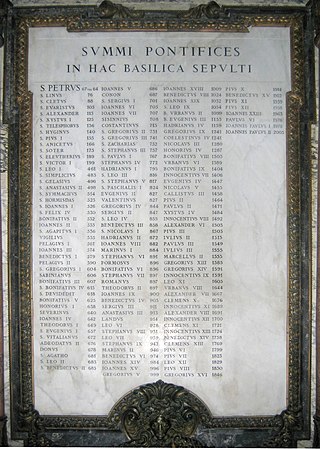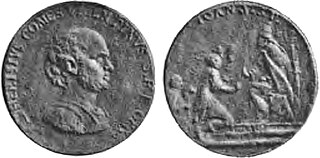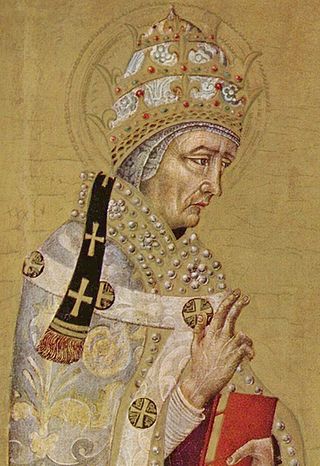Related Research Articles
Pope Anastasius II was the bishop of Rome from 24 November 496 to his death. He was an important figure in trying to end the Acacian schism, but his efforts resulted in the Laurentian schism, which followed his death. Anastasius was born in Rome, the son of a priest, and is buried in St. Peter's Basilica.
The 490s decade ran from January 1, 490, to December 31, 499.
Year 506 (DVI) was a common year starting on Sunday of the Julian calendar. At the time, it was known as the Year of the Consulship of Messala and Dagalaiphus. The denomination 506 for this year has been used since the early medieval period, when the Anno Domini calendar era became the prevalent method in Europe for naming years.

Pope Symmachus was the bishop of Rome from 22 November 498 to his death. His tenure was marked by a serious schism over who was elected pope by a majority of the Roman clergy.

Pope Hormisdas was the bishop of Rome from 20 July 514 to his death. His papacy was dominated by the Acacian schism, started in 484 by Acacius of Constantinople's efforts to placate the Monophysites. His efforts to resolve this schism were successful, and on 28 March 519, the reunion between Constantinople and Rome was ratified in the cathedral of Constantinople before a large crowd.
Pope John I was the bishop of Rome from 13 August 523 to his death. He was a native of Siena, in Italy. He was sent on a diplomatic mission to Constantinople by the Ostrogoth King Theoderic to negotiate better treatment for Arians. Although John was relatively successful, upon his return to Ravenna, Theoderic had him imprisoned for allegedly conspiring with Constantinople. The frail pope died of neglect and ill-treatment.

Pope John V was the bishop of Rome from 23 July 685 to his death on 2 August 686. He was the first pope of the Byzantine Papacy consecrated without prior imperial consent, and the first in a line of ten consecutive popes of Eastern origin. His papacy was marked by reconciliation between the city of Rome and the Empire.
Dioscorus was a deacon of the Alexandrian and the Roman church from 506. In a disputed election following the death of Pope Felix IV, the majority of electors picked him to be pope, in spite of Pope Felix's wishes that Boniface II should succeed him. However, Dioscorus died less than a month after the election, allowing Boniface to be consecrated pope and Dioscorus to be branded an antipope.
Magnus Felix Ennodius was Bishop of Pavia in 514, and a Latin rhetorician and poet.

The selection of the Pope, the Bishop of Rome and Supreme Pontiff of the Catholic Church, prior to the promulgation of In Nomine Domini in AD 1059 varied throughout history. Popes were often putatively appointed by their predecessors or by political rulers. While some kind of election often characterized the procedure, an election that included meaningful participation of the laity was rare, especially as the Popes' claims to temporal power solidified into the Papal States. The practice of Papal appointment during this period would later result in the putative jus exclusivae, i.e., the claimed but invalid right to veto the selection that Catholic monarchs exercised into the twentieth century.

The Ostrogothic Papacy was a period from 493 to 537 where the papacy was strongly influenced by the Ostrogothic Kingdom, if the pope was not outright appointed by the Ostrogothic King. The selection and administration of popes during this period was strongly influenced by Theodoric the Great and his successors Athalaric and Theodahad. This period terminated with Justinian I's (re)conquest of Rome during the Gothic War (535–554), inaugurating the Byzantine Papacy (537–752).
The Symmachian forgeries are a sheaf of forged documents produced in the curia of Pope Symmachus (498–514) in the beginning of the sixth century, in the same cycle that produced the Liber Pontificalis. In the context of the conflict between partisans of Symmachus and Antipope Laurentius the purpose of these libelli was to further papal pretensions of the independence of the bishops of Rome from criticisms and judgment of any ecclesiastical tribunal, putting them above law clerical and secular by supplying spurious documents supposedly of an earlier age.
Inportunus was a Roman aristocrat who lived during the reign of Theodoric the Great. He held the consulship without colleague in 509.
Flavius Agapitus was a Roman politician during the reign of Theodoric the Great. He held the consulship with Flavius Anastasius Paulus Probus Sabinianus Pompeius Anastasius as his colleague in 517.
Caecina Decius Faustus Albinus was a Roman politician during the reign of Theodoric the Great. He held the consulship with Eusebius in 493. Albinus is best known for being identified with the senator whom Boethius defended from accusations of treasonous correspondence with the Eastern Roman Empire by the referandarius Cyprianus, only to have Cyprianus then accuse Boethius of the same crime.
Lawrence I was Archbishop of Milan from 490 to c. 511. He is honoured as a saint in the Catholic Church and his feast day is July 25.
Rufius Magnus Faustus Avienus was a politician of the Western Roman Empire. He was appointed consul for 502 with Flavius Probus as his colleague.
Anicius Probus Faustus Niger was a politician of the Western Roman Empire who served as consul in 490 and as praetorian prefect of Italy from 509 to 512.
Rufius Postumius Festus was a Roman aristocrat who lived during the Late Roman Empire. Festus was the last consul appointed by an Emperor in the West. The next consul appointed in the West was Caecina Decius Maximus Basilius, whom king Odoacer appointed in 480, eight years after Festus.
The Constitutum Silvestri is one of five fictitious stories known collectively as the Symmachian forgeries, that arose between 501 and 502 at the time of the political battle for the papacy between Pope Symmachus (498-514) and antipope Laurentius.
References
- ↑ Historia ecclesiastiae 2.16.17, quoted in Moorhead, John (1978). "The Laurentian Schism: East and West in the Roman Church". Church History. 47 (2): 125–136. doi:10.2307/3164729. JSTOR 3164729. S2CID 162650963.
- ↑ Richards (1979). The Popes and the Papacy in the Early Middle Ages. London: Routledge and Kegan Paul. p. 69. ISBN 978-0710000989.
- ↑ Davies (trans.), Book of Pontiffs, p. 97
- ↑ Richards, Popes and the papacy, pp. 70f
- ↑ Richards, Popes and the papacy, pp. 70
- ↑ The Book of Pontiffs (Liber Pontificalis), translated with introduction by Raymond Davies (Liverpool: University Press, 1989), pp. 44, 97
- ↑ Richards, Popes and the papacy, p. 327
- ↑ Richards, Popes and the papacy, p. 71
- ↑ Davies (trans.), Book of Pontiffs, p. 98
- ↑ Richards, Popes and the papacy, p. 76
- ↑ Davies (trans.), Book of Pontiffs, p. 99